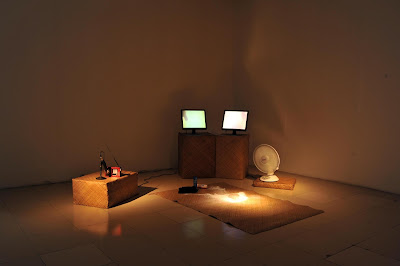1 mile² Dhaka 2014, A public art project in the older part of Dhaka City
Four screen video installation
A dual channel video series
Organized by Britto Arts Trust
Supported by Arts Collaboratory, the Netherlands.


Presently, old Dhaka is a busy
space for vendors. Alongside, there are still traditional cultural practices in
the daily lives of old Dhaka people. Old Dhaka is culturally different from
other parts of Bangladesh. There is a cultural harmony where the people live
their everyday lives. They always have different responses to the intention of
visitors to the heritage buildings in old Dhaka. Some are occupied by vendors,
businessmen, or settlers. My project was based on my own attention to the
heritage buildings, which keep socio-cultural harmony in old Dhaka. My
attention is drawn to the wooden staircases of Ruplal House, Baro Bari, Bulbul
Academy for Fine Arts (BAFA), and the location of Pance Bari in old Dhaka. The
project was a two-channel series of video works on some performative actions,
which are taken from my own collective actions within those different places.
Besides, I have achieved my own view of those places in the spirit of
historical and socio-cultural aspects. Thus, I have proceeded with my temporary
role in the attention of public sentiments in old Dhaka. I reactively tuned
myself to the present position of old Dhaka.
Outcome
In the double channel video series, I climbed
the wooden stairs and came down, making sounds. Aside from that, the
surrounding scenes (Ruplal House, Baro Bari, and Bulbul Academy for Fine Arts)
were visible in these videos.
I chose Panch Bari's dark and dusty entrance
for the installation of my video works, which is always open to the public.Lots
of vendors were selling their commodities near the entrance of Panch Bari.
During the show, everybody came to see my project, frankly. I installed
the video works on both sides of the entrance room. In one corner below, I
installed a two-channel video with a Tulashi tree, which belongs to Panch Bari
as a traditional representation, and in another part of that entrance room, a
dual-channel video series was installed, which was performed on the wooden
staircases of Ruplal House, Bulbul Lalitkala Academy, and Baro Bari. I
lit pradip (earthen lamps) in the evening, which represents both cultural and
religious Bengali tradition.
About the Steps of Ruplal House
The first one was performed on the wooden
staircases of Ruplal House, located at B K Das Lane in Farashganj. Ruplal House
is a grand 19th century building or mansion in Old Dhaka. It was initially owned
by Dhaka's Armani landlord, Aratun, and
later bought and erected jointly by two Hindu prosperous merchant brothers
named Ruplal Das and Raghunath, sons of Swarup Chandra, on the northern bank of
Buriganga, overlooking a riverfront walkway in the Farashganj district of old
Dhaka. Presently it’s occupied by vendors and non-commissioned rank army
people.
Bulbul Lalitakala Academy's (BAFA) Next
Step
The second performance on the wooden staircases
of Bulbul Lalitakala Academy Locals say British civil surgeon Dr. Weis later
bought the house built by Pogose and so it is also known as Weis House. Bulbul
Lalitakala Academy has been using the house since 1955.
About the Step of Baro Bari:
The third performance will be on the wooden
staircase of Baro Bari, which is situated at 45 B.K. Dash Lane. It was built
more than 100 years ago. Zamindar Prasanno Babu was the original owner of this
residence. Presently occupied by carpenters and vendors.
About the Step of Panch Bari
Panch Bari is not announced as a heritage
building, but its old building and old Hindu family traditionally belong to old
Dhaka culture. The last video recorded my footsteps and followed the view
of the Panch Bari area. Panch Bari means "five family home", which is
over 100 years old. The businessman, Gokul Chandra Saha, and his son, Bakul
Chandra Saha, developed their properties. Although a part of their family
migrated to India in 1947 and 1971 at the time of the liberation war of
Bangladesh. Presently, its owner, Nokul Chandra Saha, and his nephew,
Modhusudan Dey, take care of the home.
Dual Channel Video Series 'Stuck on Step...' Ruplal House, Bulbul Lalitakala Academy and Baro Bari
video sample
Stuck on Step... from
Palash Bhattacharjee on
Vimeo.
Dual Channel Video 'Stuck on Step...'Panch Bari
video sample
Stuck on Step... from Palash Bhattacharjee on Vimeo.




Image Credit: Ali Asgar
Kehkasha Sabah
And Britto Arts trust
***Old Dhaka (Puran Dhaka) is a term used to refer to the historic old city of Dhaka, the capital of modern Bangladesh. It was founded in 1608 as Jahangir Nagar, the capital of Mughal Bengal. It was one of the largest and most prosperous cities of the Indian subcontinent and the center of the worldwide Muslin trade. The Nawab of Bengal shifted the capital from Dhaka to Murshidabad in the early-1700s. With the rise of British Calcutta, Dhaka began to stagnate and came to be known as the "City of Magnificent Ruins". The British however began to develop the modern city from the mid-19th century.





















